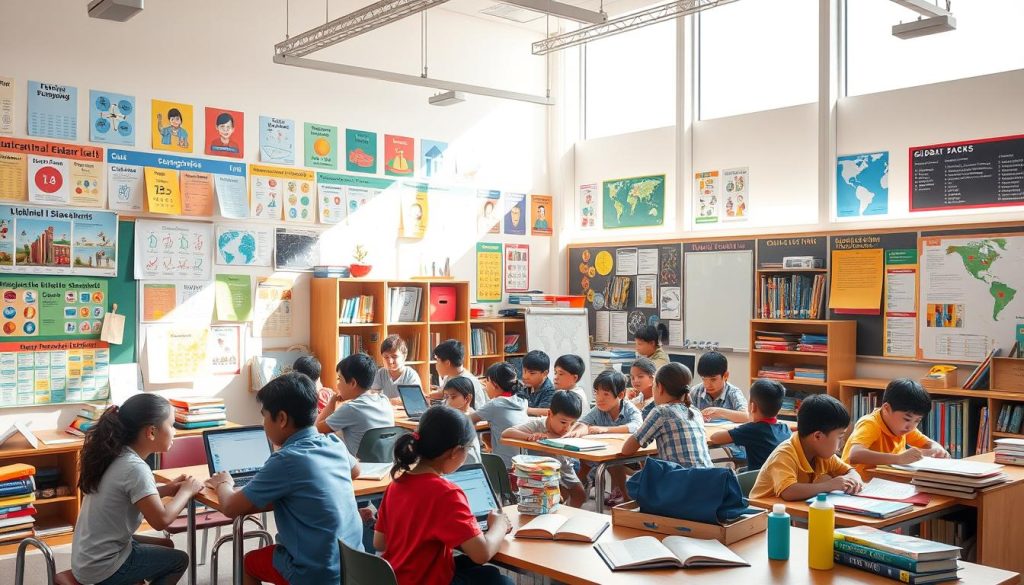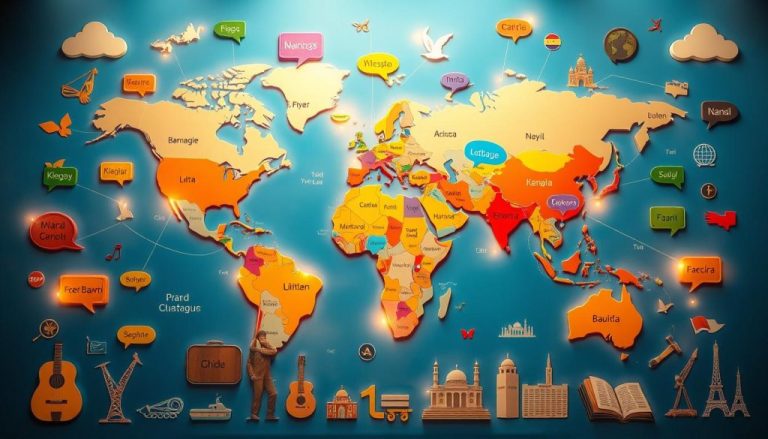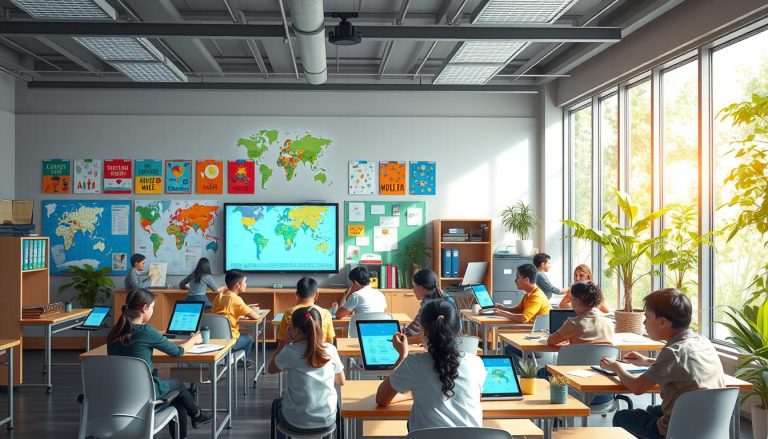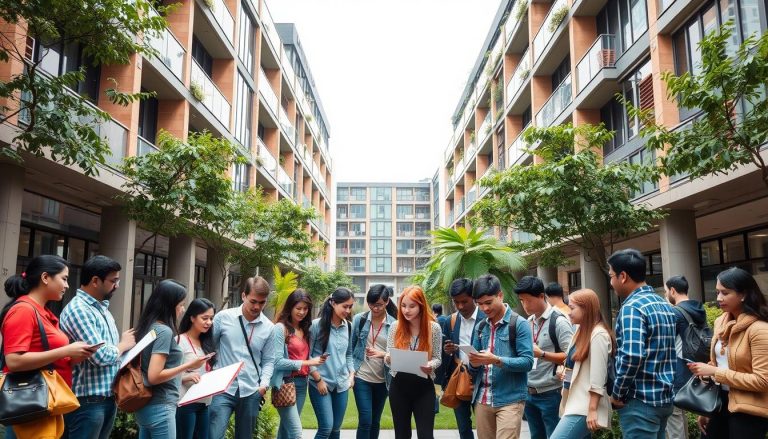U.S. Education vs. Global Systems: A Comparison
In today’s world, knowing about education systems worldwide is key. The #useducation system is changing, and it’s important to see how it stacks up against global models. This look will highlight the strengths, challenges, and chances in U.S. and international education.
Comparing U.S. and global education systems is complex. It involves looking at curricula, teaching methods, and how resources are used. By diving into these details, we can understand global education trends better. We can also see where the U.S. does well or could improve by learning from others.
Key Takeaways
- The useducation system has unique strengths and areas for improvement when compared to global education models.
- Globaleducation systems offer diverse approaches to curriculum, assessments, and teaching methods that the U.S. can learn from.
- Funding and resource allocation for #education vary significantly between the U.S. and other countries, impacting educational outcomes.
- Preparing students for the global workforce requires a focus on critical thinking, problem-solving, and cross-cultural competencies.
- Technological integration in #educationsystems is a key factor in shaping modern learning environments worldwide.
Global Education Comparisons: How the U.S. Education System Compares with Those Around the World
Understanding how the U.S. education system compares to others worldwide is key. We look at academic standards, student performance, teaching methods, and outcomes. This helps us see what’s the same and what’s different in global education.
The U.S. scores lower than many countries in math, science, and reading, PISA shows. This highlights the need for the U.S. to rethink its curriculum and teaching methods. It’s important to prepare students for the #globallearning world.
| Country | Mathematics | Science | Reading |
|---|---|---|---|
| Finland | 507 | 531 | 520 |
| Japan | 527 | 529 | 504 |
| United States | 478 | 502 | 505 |
Teaching methods and classroom cultures also vary greatly. The U.S. focuses on individual achievement and tests. But other countries value teamwork, problem-solving, and a more rounded approach to learning.
“The U.S. education system must adapt to the realities of the 21st-century global economy, where critical thinking, creativity, and cross-cultural competencies are increasingly valued.”
Policymakers and educators face big challenges. But by comparing education globally, we can find the best ways to teach. This helps the U.S. education system stay competitive and relevant in today’s world.

Exploring the Foundations of Education: Curricula and Standards
At the heart of any school system are the curricula and standards. These shape what students learn. Looking at how internationalacademicstandards and #educationreform change education worldwide is key. We’ll see how different countries teach and test their students, helping us learn about the U.S. education system.
Core Subjects and Skill Development
Every country focuses on teaching a wide range of skills. #educationmodels differ in what they stress, but some subjects are always important. These include:
- Mathematics
- Science (including natural sciences, technology, and engineering)
- Language arts (including reading, writing, and communication)
- Social studies (history, geography, civics, and economics)
- Arts and humanities (music, visual arts, and cultural studies)
By looking at how different countries teach, we learn about critical thinking and problem-solving. These are key skills for students.
Assessments and Performance Measures
Checking how well students do is vital in education. #internationalAcademicStandards set the goals, but how we measure success varies. Here are some ways:
| Assessment Type | Description |
|---|---|
| Standardized Tests | Uniform, large-scale assessments used to measure student performance against national or international standards. |
| Classroom-based Assessments | Ongoing evaluations conducted by teachers to gauge student understanding and progress within the classroom setting. |
| Portfolio Assessments | Comprehensive collections of student work, showcasing their growth and development over time. |
Looking at these different ways to test students helps us see how #educationReform works. It shows how to improve education.

Classroom Culture: Teaching Methodologies and Learning Environments
In the world of #globaleducationinsights, how classrooms work and what teachers believe is key. It shapes how students learn. Things like how teachers and students interact and the variety of learning styles matter a lot.
At the core of #crossculturaleducation is the idea that every classroom is different. Teachers everywhere use many teaching methods. Some focus on direct teaching and memorization, while others focus on hands-on learning to improve thinking and solving problems.
The #globalclassroom is a mix of different learning places, each with its own feel. Some classrooms are strict and focus on learning hard. Others are more open, where students talk a lot and work together, creating a community feel.
| Teaching Methodology | Learning Environment |
|---|---|
| Direct Instruction | Structured and Disciplined |
| Experiential Learning | Collaborative and Student-Centered |
| Inquiry-Based Learning | Flexible and Innovative |
The variety in teaching and learning places around the world shows the depth of #globaleducationinsights. It highlights the importance of understanding education in different cultures.
“Education is not the filling of a pail, but the lighting of a fire.” – William Butler Yeats
Funding and Resource Allocation: Investing in Education
Many countries, including the United States, face a big challenge: making sure everyone has access to quality education. The debate over #educationpolicy and #educationreform often focuses on where the money comes from and how it’s spent. Looking at public and private spending, and the issue of #equityineducation, helps us understand the financial side of education worldwide.
Public vs. Private Expenditures
Education funding varies across the globe. Some countries mostly use public money, while others mix public and private funds. In the U.S., public money makes up a big part of the education budget. But, private money, like tuition and endowments, also plays a key role.
The mix of public and private money affects how well students do in school. Too much private money can make education hard to get, especially for the poor. On the other hand, too much public money without careful planning can lead to waste and poor results.
Equity and Access to Quality Education
Fixing #equityineducation is key to improving education. Unequal funding and resources block quality education for some groups. Leaders and policymakers must work to make sure all students, no matter their background or where they live, get the support they need.
New ideas, like special funding for poor schools, training for teachers, and community programs, can help. These efforts can help more students achieve their goals.
“Investing in education is not just an investment in the future of our children, but in the future of our society as a whole.”
The Role of Technology in Modern Education Systems
Technology plays a key role in today’s fast-changing education world. It’s changing how students learn and interact with knowledge. Digital tools, online platforms, and new tech are making learning more engaging and effective.
Technology brings many benefits to education. It includes things like interactive whiteboards, virtual classrooms, and tools for working together online. These tools help students learn better and take a more active role in their education.
Online courses and MOOCs are also making education more accessible. They help people from all over the world learn new things. This is especially helpful for those who might not have access to good schools otherwise.
| Technology in Education | Impact |
|---|---|
| Interactive Whiteboards | Enhance visual learning and collaboration |
| Virtual Classrooms | Enable remote learning and virtual field trips |
| Personalized Learning Algorithms | Tailor educational content to individual needs |
| Online Courses and MOOCs | Provide greater access to quality education |
As the world gets more connected, technology in education is essential. It helps drive innovation, supports global teamwork, and prepares students for the future. It’s a powerful tool for success in the 21st century.
“Technology has the power to transform education, empowering students and teachers alike to explore new frontiers of learning.”
Preparing Students for the Global Workforce
In today’s world, it’s vital to prepare students for the global job market. The U.S. education system is changing to meet this need. It’s focusing more on #globaleducation, #educationacrossborders, #globallearning, and #crossculturaleducation.
Critical Thinking and Problem-Solving Skills
The U.S. education system is teaching more than just core subjects. It’s also focusing on critical thinking and problem-solving. Students learn to analyze complex issues, think outside the box, and find new solutions.
These skills are key for success in today’s fast-changing global workforce.
Cross-Cultural Competencies
The U.S. education system is also teaching students to work well with people from different cultures. They learn about diverse perspectives, understand cultural differences, and communicate in multi-cultural settings.
These abilities help them work well with colleagues from all over the world. It’s a big plus in the global job market.
FAQ
What are the key differences between the U.S. education system and education systems around the world?
The U.S. education system has its own unique traits. It differs from global systems in many ways. These include standards, teaching methods, how students are tested, and how resources are used. Knowing these differences helps us understand the strengths and challenges of each system.
How do the curriculum and academic standards in the U.S. compare to other countries?
In the U.S., education focuses on a wide range of subjects. But, many other countries have more specialized and strict standards. This can affect how much and what kind of knowledge students gain.
What are the common teaching methodologies used in U.S. classrooms versus global classrooms?
U.S. classrooms often use interactive, student-centered methods. But, other countries might stick to traditional lectures. The classroom atmosphere and teaching style can vary a lot.
How do assessment and performance measures differ between the U.S. and global education systems?
The U.S. relies heavily on standardized tests and clear performance metrics. But, other countries might use a more complete evaluation method. This includes both ongoing and final assessments.
What are the key differences in how education is funded and resources are allocated in the U.S. compared to other countries?
In the U.S., education funding comes from both public and private sources. But, the quality and access to education vary a lot. Many countries have more even funding and better access to education.
How is technology being integrated into education systems around the world, and how does it compare to the U.S.?
Technology is changing education globally, with different levels of adoption. The U.S. is trying to use technology to improve learning and get students ready for the digital world.
What are the key skills and competencies that global education systems are focusing on to prepare students for the workforce?
Many education systems worldwide are focusing on skills like critical thinking and problem-solving. They also want students to be good at communicating across cultures. The U.S. is also working to make sure its education prepares students for the global job market.






